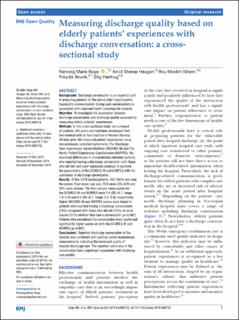| dc.contributor.author | Boge, Ranveig Marie | |
| dc.contributor.author | Haugen, Arvid Steinar | |
| dc.contributor.author | Nilsen, Roy Miodini | |
| dc.contributor.author | Bruvik, Frøydis Kristine | |
| dc.contributor.author | Harthug, Stig | |
| dc.coverage.spatial | Norway, Bergen | en_US |
| dc.date.accessioned | 2020-02-21T12:05:22Z | |
| dc.date.available | 2020-02-21T12:05:22Z | |
| dc.date.created | 2020-01-12T15:45:28Z | |
| dc.date.issued | 2019 | |
| dc.identifier.citation | Boge, R. M., Haugen, A. S., Nilsen, R. M., Bruvik, F., & Harthug, S. (2019). Measuring discharge quality based on elderly patients’ experiences with discharge conversation: a cross-sectional study. BMJ Open Quality, 8(4). | en_US |
| dc.identifier.issn | 2399-6641 | |
| dc.identifier.uri | https://hdl.handle.net/11250/2643222 | |
| dc.description.abstract | Background Discharge conversation is an essential part of preparing patients for the period after hospitalisation. Successful communication during such conversations is associated with improved health outcomes for patients.
Objective To investigate the association between discharge conversation and discharge quality assessed by measuring elderly patients’ experiences.
Methods In this cross-sectional study, we surveyed all patients ≥65 years who had been discharged from two medical units in two hospitals in Western Norway 30 days prior. We measured patient experiences using two previously validated instruments: The Discharge Care Experiences Survey Modified (DICARES-M) and The Nordic Patient Experiences Questionnaire (NORPEQ). We examined differences in characteristics between patients who reported having a discharge conversation with those who did not, and used regression analyses to examine the associations of the DICARES-M and NORPEQ with the usefulness of discharge conversation.
Results Of the 1418 invited patients, 487 (34%) returned the survey. Their mean age was 78.5 years (SD=8.3) and 52% were women. The total sample mean scores for the DICARES-M and NORPEQ were 3.9 (SD=0.7, range: 1.5–5.0) and 4.0 (SD=0.7, range: 2.2–5.0), respectively. Higher DICARES-M and NORPEQ scores were found for patients who reported having a discharge conversation (74%) compared with those who did not (15%), or were unsure (11%) whether they had a conversation (p<0.001). Patients who considered the conversation more useful had significantly higher scores on both the DICARES-M and NORPEQ (p<0.001).
Conclusions Reported discharge conversation at the hospital was correlated with positive patient experiences measurements indicating the increased quality of hospital discharge care. The reported usefulness of the conversation had a significant association with discharge care quality. | en_US |
| dc.language.iso | eng | en_US |
| dc.publisher | BMJ Publishing Group | en_US |
| dc.rights | Navngivelse-Ikkekommersiell 4.0 Internasjonal | * |
| dc.rights.uri | http://creativecommons.org/licenses/by-nc/4.0/deed.no | * |
| dc.title | Measuring discharge quality based on elderly patients’ experiences with discharge conversation: a cross-sectional study | en_US |
| dc.type | Peer reviewed | en_US |
| dc.type | Journal article | en_US |
| dc.description.version | publishedVersion | en_US |
| dc.rights.holder | © Author(s) (or their employer(s)) 2019. | en_US |
| dc.source.volume | 8:e000728 | en_US |
| dc.source.journal | BMJ Open Quality | en_US |
| dc.source.issue | 4 | en_US |
| dc.identifier.doi | 10.1136/bmjoq-2019-000728 | |
| dc.identifier.cristin | 1770882 | |
| cristin.unitcode | 203,11,2,0 | |
| cristin.unitname | Institutt for helse og funksjon | |
| cristin.ispublished | true | |
| cristin.fulltext | original | |
| cristin.qualitycode | 1 | |

